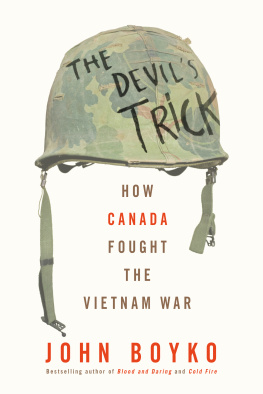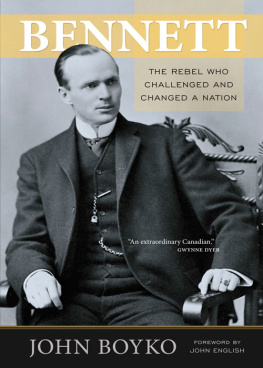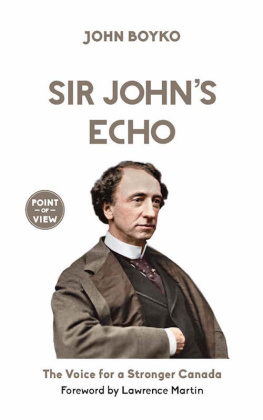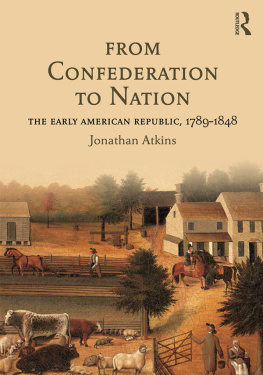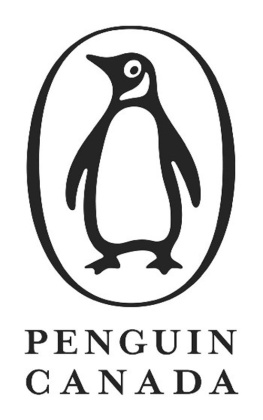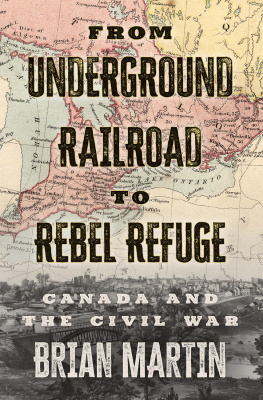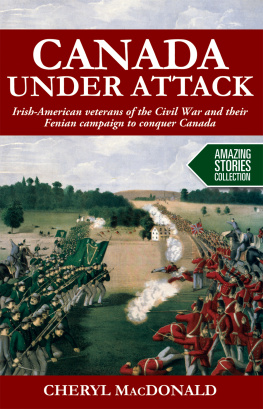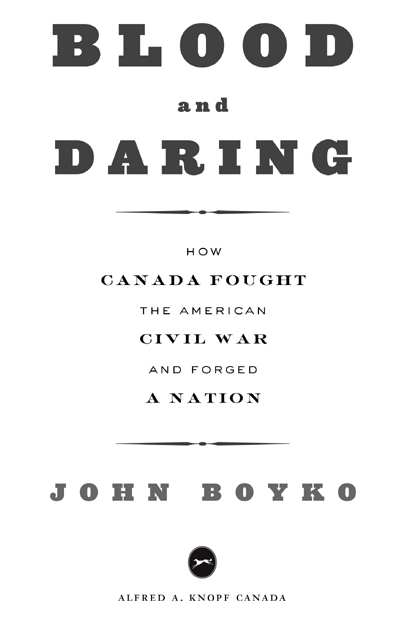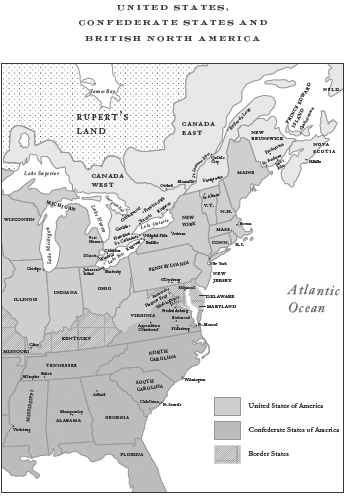Copyright 2013 John Boyko
All rights reserved under International and Pan-American Copyright Conventions. No part of this book may be reproduced in any form or by any electronic or mechanical means, including information storage and retrieval systems, without permission in writing from the publisher, except by a reviewer, who may quote brief passages in a review. Published in 2013 by Alfred A. Knopf Canada, a division of Random House of Canada Limited, Toronto. Distributed in Canada by Random House of Canada Limited and in the United States by Random House Inc.
www.randomhouse.ca
Knopf Canada and colophon are registered trademarks.
Library and Archives Canada Cataloguing in Publication
Boyko, John, 1957
Blood and daring : How Canada fought the American Civil War and forged a nation / John Boyko.
Includes bibliographical references.
eISBN: 978-0-307-36145-5
1. United StatesHistoryCivil War, 18611865Participation, Canadian. 2. United StatesHistoryCivil War, 18611865Influence. 3. CanadaHistory18411867. 4. CanadaHistoryConfederation, 1867. 5. CanadaPolitics and government18411867. 6. CanadaRelationsUnited StatesHistory.
7. United StatesRelationsCanadaHistory. I. Title.
E540.C25B69 2013 973.70971 C2012-905614-6
Cover design by CS Richardson
Cover images: Abraham Lincoln, three-quarter length portrait by Anthony Berger, Prints and Photographs Division, Library of Congress, LC-DIG-ppmsca-19305; Battle of Nashville by Howard Pyle Minnesota Historical Society / CORBIS; Hon. Sir John A. MacDonald from the Brady-Handy Collection, Prints and Photographs Division, Library of Congress, LC-DIG-cwpbh-00412
v3.1
This book is dedicated to Kenzie McIntyre, in the perhaps naive but still worthwhile hope that when she grows up, wars will have become merely sad stories of human failing, known only in dusty old books.

CONTENTS

INTRODUCTION

BAD NEIGHBOURS IN
A DANGEROUS NEIGHBOURHOOD
T HE GHOSTS REMAIN ACTIVE . Even after the passage of more than a century and a half, the American Civil Wars ideas, promise and pain still resonate. An understanding of the war is crucial to all who wish to comprehend Americas civic conversationto comprehend America itself. Similarly, no one can fully understand Canada without appreciating that the war was an essential factor in the countrys birth, when and how it came about, as well as shaping the fundamental ideas upon which it is based. While saving itself by creating itself, Canada was intricately involved in the wars cause and course. Despite the efforts of Americas wartime leaders, Canadas actions during and after the conflict kept Canada from becoming American. We owe it to ourselves to understand the Civil Warto heed its whispering ghosts.
Before embarking on our journey of understanding, we must know and accept a few things. First, throughout the Civil War and the years shouldering it, the vast and ruggedly beautiful land north of the American border was home to members of proud First Nations and communities of British, French and other Europeans, some of whom were recent arrivals while others had roots going back several generations. Britain had claimed jurisdiction over it all, except for a broad swath surrounding James and Hudson Bays called Ruperts Land, which was owned and governed by the Hudsons Bay Company. There were small British communities gathered around Victoria and Vancouver, hugging Newfoundlands craggy shore and on Prince Edward Island. The Maritime colonies of Nova Scotia and New Brunswick were more populous and prosperous. Bigger and richer still was Canada, united under a single government but composed of Canada East and West and occupying what is now the southern portions of Ontario and Quebec.
We must accept a world where the air was empty and the sky silent. The trans-Atlantic cable had been laid but did not yet work, and the marvel of the telegraph was new but unreliable. Messages often took weeks to bounce back across the Atlantic and days even within North America. A momentous battle such as Gettysburg could have been won by Confederate General Lee, not with a thousand more troops, but rather if hed had a couple of cell phones. While railways were used to great effect, Lees army got to Gettysburg largely by walking from Virginia to Pennsylvaniait was not quick. Canadian political leaders could meet with British authorities only after a long ocean journey and were often gone for months at a time, grinding political progress to a halt.
We must also disenthrall ourselves of current myths, including that of the undefended border. Those struggling through the Civil War years bore memories not of Canadian-American friendship and economic and cultural integration but of more than a century of suspicion, hatred and bloodshed. Canada and the United States were bad neighbours in a dangerous neighbourhood.
At the outset of the Civil War, collective memories remained alive of the French and Indian War when, in the late 1750s and early 1760s, New York State, the Ohio Valley, Nova Scotia, Montreal and Quebec City were battlefields. In November 1775, Montreal fell to American troops, and Benedict Arnolds men tried but could not take Quebec City.
Congress dispatched three delegates, one of whom was Benjamin Franklin, to woo Quebecers to the rebel cause. They failed. The Qubcois had little interest in joining a ragtag group of rebellious colonies, only two of which allowed the practice of their religion, and whose army mistreated civilians, and stole property and food.
The Declaration of Independence made direct mention of the Quebec Act as one of the grievances levelled against the British king. As the Revolutionary War progressed, the Articles of Confederation were developed to serve as a constitution for the Continental Congress, which had become a government. Article 16 made it easy for Canada to join: Canada acceding to this Confederation, and entirely joining in the measures of the United States, shall be admitted into and entitled to all the advantages of this Union. Despite the appeal, neither the Quebecers, the Quebec government nor the Catholic Church, which was enormously powerful in the colony, had any interest in becoming American.
The Revolution was Americas first civil war. About a third of the American colonists wanted nothing to do with what Adams, Jefferson and the others were selling. With every British military defeat, more of those loyal to the Crown left or were driven out. Some fled to Britain while others went south, but most escaped to what remained of British North America. Eventually, about thirty thousand moved to Nova Scotia and ten thousand to Quebec. A number of freed Blacks emigrated.
Britain had lost thirteen of its North American colonies and did not fancy losing the others. Wary of allowing demographic and economic growth to create a new powerhouse such as wealthy and populous Virginia, it split Nova Scotia to create New Brunswick. It divided Quebec into Upper Canada (Ontario) and Lower Canada (Quebec). A new political system was installed that afforded a semblance of self-rule with British-appointed governors in charge. A border was loosely drawn, and American fishers were granted inland rights. Those long established in the suddenly growing British colonies shared with the revolutions refugees and the newcomers from the British Isles a deep respect for British political values and an abhorrence of the ideals and aspirations upon which the American Revolution had been based. They were determined to remain separate from the United States.


